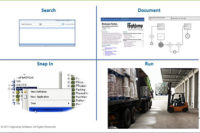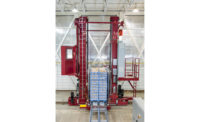Cold Supply Chain & Logistics: Looking Beyond the Horizon

Manufacturers, distributors, shippers and port authorities brace for the 2014 Panama Canal expansion.
When looking beyond the horizon, for many importers and exporters, it’s just a sea of blue. Literally. But there’s certainly more than meets the eye when it comes to transporting refrigerated and frozen products in and out of the United States.
That’s why food manufacturers, distributors, shippers and port authorities are bracing for the 2014 Panama Canal expansion, a multi-billion dollar event.
The Panama Canal opened in January 1914, and since then through December 2010, it experienced more than 1 million ship transits, delivering more than 8 billion tons of goods worldwide.
However, today, the 51-mile ship route experiences a host of logistics issues.
For starters, it can only accommodate Panamax ships (1,000 feet in length by 100 feet in width). And while much of the world is shrinking (think phones, computers and cars), import/export ships are increasing in size by 50%, some experts say.
And, up until a few months ago, the Port of Miami had a lack of funding to dredge depth into its port in order to hold the larger-sized ships. However, following the Miami Port conference earlier this year though, Florida Governor Rick Scott committed $77 million of funding to begin digging an additional 50 feet.
Furthermore, the expansion doesn’t increase or decrease transit time.
“The expansion just accommodates larger vessels,” says Dr. Geraldine Knatz, president of International Association of Ports and Harbors, Los Angeles. “Therefore, importers/exporters will have to grapple with the question of total transit time and total overall costs and whether or not they want refrigerated food, like exotic fruit from Thailand, to take 10-11 days longer to get to the shelves.”
Divide and conquer
Just like with any expansion, those who transport goods via the Panama Canal may encounter some roadblocks. But for the most part, many say that this event will create little to no impact.
“We’re not convinced there would be much of an impact,” Knatz says. “On larger vessels that will be able to transit the Panama Canal, there would be room for more specialized reefer containers carrying items like beef from New Zealand or seafood from Vietnam and Thailand.”
Once the expansion is complete, the Mississippi State Port Authority (MSPA) won’t experience any appreciable impact either, according to Donald Lee, executive director and CEO for the Gulfport, Miss.-based port authority.
“The largest impact will likely be to the processors of chicken, beef, pork and fruit,” he adds. “These various food products are increasingly being shipped in refrigerated ocean-going containers and trending away from refrigerated break-bulk vessels. Ever larger container vessels will realize the full potential of an enlarged Panama Canal.”
Plus, with additional Canal capacity, traffic congestion may lessen, says Brooks Royster, vice president of MTC Logistics, a refrigerated and frozen warehousing company based in Baltimore, Md.
“[The additional Canal capacity] allows for quicker Canal entrance for expensive reefer vessels that have traditionally chosen not to transit, and head instead for a quicker turnaround afforded by the U.S. West Coast,” Royster says.
The most logical steps cold food processors should be doing now, Lee advises, are to “develop relationships with various container carriers and establish pricing and routing guidelines.” And, frozen product shippers and importers should begin considering how to operate so that their product can be containerized.
“The MSPA has every intention of attracting another container carrier with a larger global reach,” Lee adds. “This additional carrier will ultimately offer expanded services to and from the MSPA that will likely entail mother and/or feeder vessels, which will greatly expand the MSPA’s interaction with a larger segment of the world market.”
Free Trade Agreement
Just like the many pros and cons circling around the Panama Canal expansion, the Free Trade Agreement (FTA) with South Korea opens the floodgates to more import/export opportunities-and problems.
“Trade issues with China and Russia will continue to hamper the exportation of frozen meat products,” Lee says. “In addition, these countries will continue to try and produce an ever larger percentage of their meat/poultry needs domestically for their own consumption.”
On the other hand, those countries who have a Fair Trade Agreement in place with the United States will benefit from the supply chain logistics.
“Those trading partners that have FTA’s and that have invested in their banking and maritime infrastructure will see growth as they will be able to support the movement of goods,” Royster says.
Meanwhile, processors should begin seeking out FTA opportunities.
“Processors in the perishable industry should examine if there are additional export opportunities in countries that had not been serviced before,” Knatz says.
To further the trade agreement, the Port of Los Angeles launched “Trade Connect,” an introductory workshop that covers the basics of exporting, including cost, risks and steps involved.
“We organize symposiums with expert panels that can help the starting exporter with information to develop those export opportunities,” Knatz adds.
Likewise, MSPA is undergoing a $570 million port improvement project that’s projected to be completed in 2017, Lee says.
“This new container carrier may service the Far East and/or the West Coast of South America,” he adds.
Whichever way the ship travels, cold food manufacturers, distributors, shippers and port authorities continue to look beyond the horizon, as they await “bigger” and better changes to the way food enters and exits the United States.
Looking for a reprint of this article?
From high-res PDFs to custom plaques, order your copy today!









